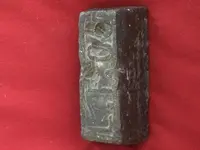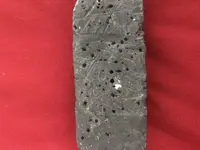You are using an out of date browser. It may not display this or other websites correctly.
You should upgrade or use an alternative browser.
You should upgrade or use an alternative browser.
Old lead ingot L.F CO antique shop find
- Thread starter Snorlax
- Start date
sutphin
Gold Member
- Joined
- Oct 2, 2013
- Messages
- 8,344
- Reaction score
- 4,467
- Golden Thread
- 0
- Location
- brunswick md
- Detector(s) used
- WHITES 5900, MXT 300, MXT PRO, MXT ALL PRO/ 8X6 SEF COIL
- Primary Interest:
- Relic Hunting
COULD BE FOR TELEPHONE OR OLD SEWER PIPE LEAD...
No gold in NY
Bronze Member
- Joined
- Mar 22, 2015
- Messages
- 1,688
- Reaction score
- 2,921
- Golden Thread
- 0
- Detector(s) used
- Whites Coin Master,
Whites Gold Master GMT, Whites MXSport
High banker/dredge,
DIY hand trommel,
DIY Miller table,
DIY fluidbed gold trap sluice,
Keene A-52 A-52s
2186 Wheaties
- Primary Interest:
- Other
Back in the day poured lead was commonly used in the joints of sewer pipes. I have seen many examples of this in older homes. And where did plumbers get the lead? They purchased bars of it like the one you have. Your bar is a conservation piece. As far as value, you could sell it to a black powder shooter. They seem to prefer "old lead" to make the musket balls.
There's many different types of lead bars used for many different things and have many different mixtures to the bars/ingots, 3000+ Compositions and Grades
Tin/lead used for plumbing joints, silver/lead/Babbitt Lead/Pig Lead/Bullion Lead/Copper/Nickel/3% antimonial bullion (typically used for sailboat keels) or 6% antimonial bullion.
Remember not all lead is created equal.
Tin/lead used for plumbing joints, silver/lead/Babbitt Lead/Pig Lead/Bullion Lead/Copper/Nickel/3% antimonial bullion (typically used for sailboat keels) or 6% antimonial bullion.
Remember not all lead is created equal.
trapperart
Platinum Member
- Joined
- Dec 12, 2015
- Messages
- 16,162
- Reaction score
- 13,042
- Golden Thread
- 2
- Location
- Maryland's eastern shore
- 🥇 Banner finds
- 2
- Detector(s) used
- whites MXTPro whites MXSport
- Primary Interest:
- Metal Detecting
Congrats
trdking
Gold Member
- Joined
- Feb 28, 2015
- Messages
- 5,139
- Reaction score
- 7,923
- Golden Thread
- 0
- Location
- Fullerton CA
- Detector(s) used
- Minelab CTX 3030
AT Pro
- Primary Interest:
- All Treasure Hunting
The first old phone lines under the streets were encased in lead jackets and poured lead was placed around their entry points to seal the moisture out of the assemblies. I still see this in the older manholes. The antimony solder for copper piping is lead free to keep it out of the drinking water. The old cast iron sewer pipes were assembled with wadding then lead poured into he joints then hammered tight. Neither of the lead applications have been in use for many years. At least 50 years for the sewer pipe. Your lead bar is worth about .35 a pound in scrap.
The first old phone lines under the streets were encased in lead jackets and poured lead was placed around their entry points to seal the moisture out of the assemblies. I still see this in the older manholes. The antimony solder for copper piping is lead free to keep it out of the drinking water. The old cast iron sewer pipes were assembled with wadding then lead poured into he joints then hammered tight. Neither of the lead applications have been in use for many years. At least 50 years for the sewer pipe. Your lead bar is worth about .35 a pound in scrap.
But to end user the lead can be $1.00 a pound. To a scrap it's not a high ticket item, I didn't even handle the lead, more trouble than it was worth.
Similar threads
- Suggestion
- Replies
- 6
- Views
- 212
Users who are viewing this thread
Total: 1 (members: 0, guests: 1)
Latest Discussions
-
-
-
-
Confederate Gold from the Civil War was Found in a Shocking Place
- Latest: achanceforgold
-
-
Naturallly Occuring Formation OR Manmade Treasure Marker/Sign?
- Latest: Puff the Tragic Wagon






